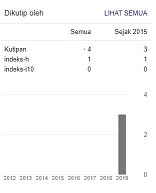PENGARUH HARGA MINYAK DUNIA, KESTABILAN POLITIK DAN SUKU BUNGA TERHADAP NILAI TUKAR DI INDONESIA
Abstract
Keywords
Full Text:
PDFReferences
Albulescu, C. T., & Ajmi, A. N. (2021). Oil price and US dollar exchange rate: Change detection of bi-directional causal impact. Energy Economics, 100(April), 105385. https://doi.org/10.1016/j.eneco.2021.105385
Amanda, C. (2021). The risk of sub-prime mortgage crisis and COVID-19 pandemic: Lesson learned from indonesia. Indonesian Journal of Business and Entrepreneurship …, 7(1), 73–81.
Areli Bermudez Delgado, N., Bermudez Delgado, E., & Saucedo, E. (2018). The relationship between oil prices, the stock market and the exchange rate: Evidence from Mexico. North American Journal of Economics and Finance, 45(February), 266–275. https://doi.org/10.1016/j.najef.2018.03.006
Baek, J. (2021). A new look at the oil prices and exchange rates nexus: a quantile cointegrating regression approach to south korea. Applied Economics, 53(56), 6510–6521. ttps://doi.org/10.1080/00036846.2021.1946475
Bahmani-Oskooee, M., Hadj Amor, T., Nouira, R., & Rault, C. (2019). Political Risk and Real Exchange Rate: What Can We Learn from Recent Developments in Panel Data Econometrics for Emerging and Developing Countries? Journal of Quantitative Economics, 17(4), 741–762. https://doi.org/10.1007/s40953-018-0145-4
Beckmann, J., Czudaj, R. L., & Arora, V. (2020). The relationship between oil prices and exchange rates: Revisiting theory and evidence. Energy Economics, 88, 104772. https://doi.org/10.1016/j.eneco.2020.104772
Business, T., Shahrin, M., Bahar, B., Karia, A. A., & Radin, D. N. (2019). An empirical analysis of oil price and exchange rate : evidence from the selected oil exporting and oil importing countries. 10(3), 8–9.
Draz, M. U., Ahmad, F., Gupta, B., & Amin, W. (2019). Macroeconomic fundamentals and exchange rates in South Asian economies. Journal of Chinese Economic and Foreign Trade Studies, 12(2), 104–119. https://doi.org/10.1108/jcefts-01-2019-0007
Fraj, H., Hadj Fraj, S., Manar Najeh Bouchoucha, E., Maktouf, S., & Manar, E. (2020). Political stability and economic growth: the role of exchange rate regime. 104586. https://mpra.ub.uni-muenchen.de/104586/1/MPRA_paper_104586.pdf
Gantman, E. R., & Dabós, M. P. (2018). Does trade openness influence the real effective exchange rate? New evidence from panel time-series. SERIEs, 9(1), 91–113. https://doi.org/10.1007/s13209-017-0168-7
Golit, P., Salisu, A., Akintola, A., Nsonwu, F., & Umoren, I. (2019). Exchange Rate and Interest Rate Differential in G7 Economies. Buletin Ekonomi Moneter Dan Perbankan, 22(3), 263–286. https://doi.org/10.21098/bemp.v22i3.1147
Harjunawati, S., Hendarsih, I., Addin, S., & Marthanti, A. S. (2021). Effect of Inflation, BI Rate And Net Export To USD Central Exchange Rate to Rupiahs In Bank Indonesia For 2005-2019. Moneter - Jurnal Akuntansi Dan Keuangan, 8(1), 85–89. https://doi.org/10.31294/moneter.v8i1.10338
Iqbal, Z., Muhammad Akbar, & Amjad, W. (2021). Nexus of Gold Price-Exchange rate-interest rate-Oil Price: Lessons for Monetary Policy in Pakistan. NUML International Journal of Business & Management, 16, 1–16. https://doi.org/10.52015/nijbm.v16i1.50
Ismanto, H., & Pebruary, S. (2021). Aplikasi SPSS dan Eviews dalam Analisis Data Penelitian.
Jayawarsa, A. K., Wulandari, I. G. A. A., Saputra, K. A. K., & Saputri, N. M. M. D. (2021). Public financial deposits in state owned banks: from an inflation perspective and bank indonesia interest rates. International Journal of Business, Economics and Law, 24(1), 105–112.
Kataria, N., & Gupta, A. (2018). Determinants of Real Effective Exchange Rates in Emerging Market Economies. SSRN Electronic Journal. https://doi.org/10.2139/ssrn.3144172
Kaufmann, D., Kraay, A., & Mastruzzi, M. (2011). The worldwide governance indicators: Methodology and analytical issues. Hague Journal on the Rule of Law, 3(2), 220–246. https://doi.org/10.1017/S1876404511200046
Kocaarslan, B., Soytas, M. A., & Soytas, U. (2020). The asymmetric impact of oil prices, interest rates and oil price uncertainty on unemployment in the US. Energy Economics, 86, 104625. https://doi.org/10.1016/j.eneco.2019.104625
Koynja, J. J., Sofwan, S., & Rusnan, R. (2020). Transaksi perdagangan melalui sistem elektronik oleh pelaku usaha e-commerce dalam memenuhi target penerimaan perpajakan. Jurnal Kompilasi Hukum, 4(2), 77–96.
Kumar, S. (2019). Asymmetric impact of oil prices on exchange rate and stock prices. Quarterly Review of Economics and Finance, 72, 41–51. https://doi.org/10.1016/j.qref.2018.12.009
Kurniasih, A., & Restika, Y. (2015). The influence of Macroeconomic Indicators and Foreign Ownership on Government Bond Yields: A Case of Indonesia. Mediterranean Journal of Social Sciences, 6(5), 34–42. https://doi.org/10.5901/mjss.2015.v6n5s5p34
Malik, F., & Umar, Z. (2019). Dynamic connectedness of oil price shocks and exchange rates. Energy Economics, 84(xxxx), 104501. https://doi.org/10.1016/j.eneco.2019.104501
Meivinia, L. (2019). Pengaruh Likuiditas, Profitabilitas, Struktur Modal, Dan Suku Bunga Terhadap Nilai Perusahaan. Jurnal Muara Ilmu Ekonomi Dan Bisnis, 2(2), 377. https://doi.org/10.24912/jmieb.v2i2.1562
Mensi, W., Rehman, M. U., & Al-Yahyaee, K. H. (2020). Time-frequency co-movements between oil prices and interest rates: Evidence from a wavelet-based approach. North American Journal of Economics and Finance, 51(April), 1–13. https://doi.org/10.1016/j.najef.2018.08.019
Mohsen, A., Sadat, S. F., & Haidery, J. (2021). Effects of the macroeconomic variables on GDP growth of Afghanistan. June.
Musyoka, N., & Ocharo, D. K. N. (2018). Real Interest Rate, Inflation, Exchange Rate, Competitiveness and Foreign Direct Investment in Kenya. American Journal of Economics, 3(1), 1–18. https://doi.org/10.47672/aje.330
Nabi, G., Bhat, K., & Ghazanfar, F. (2021). Does Budget Deficit and Political Stability Effect Real Exchange Rate in South Asian Countries? Global Management Sciences Review, VI(I), 26–38. https://doi.org/10.31703/gmsr.2021(vi-i).03
Onour, I. A., & Sergi, B. S. (2021). The impact of a political shock on foreign exchange markets in a small and open economy: A dynamic modelling approach. Journal of Central Banking Theory and Practice, 10(3), 137–152. https://doi.org/10.2478/jcbtp-2021-0028
Özen, E., Özdemir, L., & Grima, S. (2020). The Relationship between the Exchange Rate, Interest Rate and Inflation: The Case of Turkey. Scientific Annals of Economics and Business, 67(2), 259–275. https://doi.org/10.47743/SAEB-2020-0014
Qing, Y. K., & Kusairi, S. (2019). The Effect of Money Supply, Exchange Rate, and Interest Spread toward the Performance of Stock Market in Malaysia. Widyakala Journal, 6(2), 142. https://doi.org/10.36262/widyakala.v6i2.217
Saidu, M. T., Naseem, N. A. M., Law, S. H., & Yasmin, B. (2021). Exploring the asymmetric effect of oil price on exchange rate: Evidence from the top six African net oil importers. Energy Reports, 7, 8238–8257. https://doi.org/10.1016/j.egyr.2021.07.037
Seran, S. (2020). Metode Penelitian Ekonomi dan Sosial.
Sheikh, U. A., Asad, M., Ahmed, Z., & Mukhtar, U. (2020). Asymmetrical relationship between oil prices, gold prices, exchange rate, and stock prices during global financial crisis 2008: Evidence from Pakistan. Cogent Economics and Finance, 8(1). https://doi.org/10.1080/23322039.2020.1757802
Susilawati, S., Falefi, R., & Purwoko, A. (2020). Impact of COVID-19’s Pandemic on the Economy of Indonesia. Budapest International Research and Critics Institute (BIRCI-Journal): Humanities and Social Sciences, 3(2), 1147–1156. https://doi.org/10.33258/birci.v3i2.954
Tafa, J. (2015). Relationship between exchange rates and interest rates: Case of Albania. Mediterranean Journal of Social Sciences, 6(4), 163–170. https://doi.org/10.5901/mjss.2015.v6n4p163
Urom, C., Guesmi, K., Abid, I., & Dagher, L. (2021). Dynamic integration and transmission channels among interest rates and oil price shocks. Quarterly Review of Economics and Finance, xxxx. https://doi.org/10.1016/j.qref.2021.04.008
Wen, F., Xiao, J., Huang, C., & Xia, X. (2018). Interaction between oil and US dollar exchange rate: nonlinear causality, time-varying influence and structural breaks in volatility. Applied Economics, 50(3), 319–334. https://doi.org/10.1080/00036846.2017.1321838
Wicaksono, T. I., Yanuar, A. A., & Lalu, H. (2016). Perancangan Proses Menetapkan Risiko Dan Peluang Berdasarkan ISO 9001:2015 Klausul 6.1 Dengan Pendekatan ISO 31000:2009 Menggunakan Metode Business Process Improvement Di CV.XYZ. Jurnal Rekayasa Sistem & Industri (JRSI), 3(04), 72. https://doi.org/10.25124/jrsi.v3i04.193
Wirtschaft, Z. B. W. L. (1999). Digitales Archiv. Materials Testing, 41(7–8), 307–307. https://doi.org/10.1515/mt-1999-417-807
Živkov, D., Njegić, J., & Balaban, S. (2019). Revealing the nexus between oil and exchange rate in the major emerging markets—The timescale analysis. International Journal of Finance and Economics, 24(2), 685–697. https://doi.org/10.1002/ijfe.1686
DOI: http://dx.doi.org/10.53712/jmm.v7i2.1501
Refbacks
- There are currently no refbacks.
Indexing:
Aliansi:
Reference Manager:
View Statistic
Published by Prodi Manajemen Fakultas Ekonomi Universitas Madura
Jl. Raya Panglegur Km 3,5 Pamekasan
Phone: (0324) 322231
website: http://ejournal.unira.ac.id/index.php/jurnal_makro_manajemen/index
Email: makro@unira.ac.id
MAKRO by Universitas Madura is licensed under a Creative Commons Attribution 4.0 International License.







